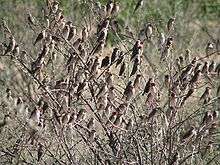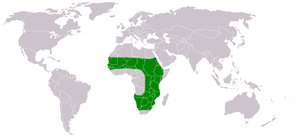Red-billed quelea
| Red-billed quelea | |
|---|---|
_(6040990915).jpg) | |
| Male Q. q. athamii, South Africa | |
| Scientific classification | |
| Kingdom: | Animalia |
| Phylum: | Chordata |
| Class: | Aves |
| Order: | Passeriformes |
| Family: | Ploceidae |
| Genus: | Quelea |
| Species: | Q. quelea |
| Binomial name | |
| Quelea quelea (Linnaeus, 1758) | |
The red-billed quelea (Quelea quelea), also known as the red-billed weaver or red-billed dioch, is the world's most abundant wild bird species, with an estimated adult breeding population of 1.5 billion pairs.[2] Some estimates of the overall population have been as large as 10 billion.[3] The entire population is found in sub-Saharan Africa and is generally absent from thickly forested regions and the southern reaches of South Africa. It is a small passerine bird of the weaver family, Ploceidae.
Description


Red-billed quelea are small birds and average-sized weaver-finches. They grow to 11–13 cm (4.5–5 in) long and attain a weight of 15 to 20 g (0.5-0.7 oz). During the breeding stage, the adult male is distinguished by his more colorful plumage and red bill. Breeding plumage in male queleas is unusually variable: comprising a facial mask which ranges from black to white in color, and breast and crown plumage which varies from yellowish to bright red. For the rest of the year both males and fledged non-breeding birds have plumage that resembles that of the adult female, which is overall a cryptic beige and cream coloration. The female's bill is yellow during breeding, and red during the non-breeding season.
Distribution

The distribution area of the red-billed quelea covers the majority of sub-Saharan Africa, excluding deep portions of rain forest in central Africa. It is also generally absent from the southern portion of South Africa. It was introduced to Reunion in 2000.
Ecology
Red-billed quelea live and breed in huge flocks which can take up to 5 hours to fly past. They live mostly in steppe and savanna regions, but do not avoid human settlements. While foraging for food they may fly large distances each day without tiring. Their life expectancy is two to three years.
Reproduction
Breeding is localized and erratic but often colonies include tens of thousands to millions of pairs. The breeding season begins with the seasonal rains, which come at different times in different parts of their range – starting at the northwestern edge around the beginning of November. The breeding males first weave half-complete ovoid nests from grass and straw. After the female has examined the construction and mating has occurred, both partners complete the weaving of the nest. The female lays two to four light blue eggs, and incubates them for twelve days.
After the chicks hatch, they are nourished for some days with caterpillars and protein-rich insects. After this time parents change to feeding the nestlings mainly seeds. The young birds fledge and become independent enough to leave their parents after approximately two weeks in the nest. They are sexually mature after just one year, but many juveniles die before reaching this stage and males may weave nests that go unused if the female dies.
Food
The food of the red-billed quelea consists of annual grasses, seeds and grain. As soon as the sun comes up, they come together in their huge flocks and co-operate in finding a suitable feeding place. After a successful search, they settle rapidly and can cause serious damage to crops. In the middle part of the day they rest in shady areas near water and preen. Birds seem to prefer drinking at least twice a day. In the evening they once again fly in search of food.
Predation by other animals and humans
Being such a significant element of the savanna biomass, red-billed quelea flocks and colonies attract large numbers and diverse types of predators and scavengers. Birds known to live extensively off quelea include herons, storks, hawks, owls, hornbills, rollers, kingfishers, shrikes and corvids. Additionally, snakes, lizards and several types of mammals are regular predators, especially rodents and small carnivores. Some human populations also eat red-billed, and during their breeding season the Hadza of northern Tanzania eat quelea chicks by the thousand.
The species is a serious agricultural pest, damaging millions of kilograms of cereal grains each year in Africa.[4] Due to the large numbers and localised devastation of cereal crops, control actions have been undertaken. As many as 150–180 million birds have been killed but this appeared to have no effect on the overall quelea population and only temporary relief from crop damage. Many non-target birds appeared to have also been killed in these control operations and might have had severe population deprivations as a result.
Due to the birds' living in communal roosts of many thousands after the young have flown, they can be easily targeted by special squads from the local agricultural organisation. When a village has complained of a flock stripping crops, the team will arrive at sundown when the mass roost has been located and will dig a shallow hole under the main roost trees. They then place a bundle of dynamite and roll a barrel half-filled with a petrol-diesel mixture that on detonation sends a huge blast into the tree, instantly killing the majority of roosting birds which then can be used as food for village dogs or pigs.
References
- ↑ BirdLife International (2012). "Quelea quelea". IUCN Red List of Threatened Species. Version 2013.2. International Union for Conservation of Nature. Retrieved 26 November 2013.
- ↑ Weaver Bird Natural History
- ↑ http://www.trails.com/arts/amazing-bird-records.aspx
- ↑ Shefte, N.; Bruggers, R. L.; Schafer Jr., E. W. (April 1982). "Repellency and Toxicity of Three Bird Control Chemicals to Four Species of African Grain-Eating Birds". The Journal of Wildlife Management. 46 (2): 453–457. doi:10.2307/3808656. JSTOR 3808656.
External links
| Wikimedia Commons has media related to Quelea quelea. |
- Red-billed quelea on Weaver Watch
- Red-billed quelea - Species text in The Atlas of Southern African Birds.
- Queensland government red-bellied quelea risk assessment
- NRI Quelea Breeding Forecast Models
- Red-billed quelea videos on the Internet Bird Collection
